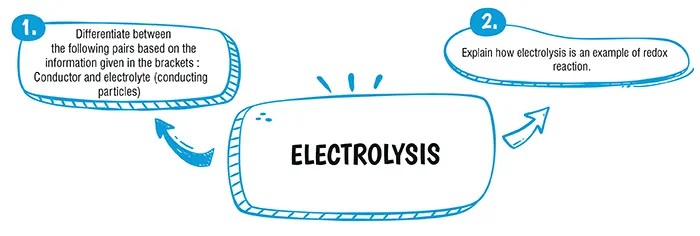Table of Contents

Ans. (D) All of the above
Explanation:
The sugar cane solution is a covalent compound. When it is dissolved in water, it does not dissociate to give free ions which could migrate to cathode or anode. Hence, sugar solution is a bad conductor of electricity. The sodium chloride solution mainly consists of free sodium and chloride ions which could migrate to positively charged electrodes. Hence, the solution of sodium chloride is a good conductor of electricity.
Ans. (b) Impure metal is made of anode.
Explanation:
In electrolytic refining, impure metal is made the anode and a thin strip of pure metal is used as cathode.
Explanation:
I. Sodium chloride solution (NaCl) is a strong electrolyte. It dissociates almost completely when dissolved in water to give free mobile ions. Hence, NaCl conducts electricity in large quantities.
II. Acetic acid is a weak electrolyte so it conducts electricity in small quantities.
III. Sugar is a nonelectrolyte. It has only molecules and no ions. Hence, it does not allow current to pass through.
Explanation:
(i) Conductor - conduction due to electrons; Electrolyte - conduction due to ions.
(ii) Cations are formed by the loss of electrons from an atom / or oxidation of an atom / donating electrons.
Anions are formed by the gain of electrons by an atom/reduction of an atom/ accepting electrons.
(iii) Acid - forms H^+ ions or hydronium (ions in solution) or H_3O^+ or hydrogen ions.
Alkali - forms hydroxyl (ion) or OH^- (in solution) or hydroxide ion/hydroxide.
Explanation:
(i) Conductor - conduction due to electrons; Electrolyte - conduction due to ions.
(ii) Cations are formed by the loss of electrons from an atom / or oxidation of an atom / donating electrons.
Anions are formed by the gain of electrons by an atom/reduction of an atom/ accepting electrons.
(iii) Acid - forms H^+ ions or hydronium (ions in solution) or H_3O^+ or hydrogen ions.
Alkali - forms hydroxyl (ion) or OH^- (in solution) or hydroxide ion/hydroxide.
\text{Cathod} \underset{\text{copper ions}}{Cu^{2+}} + 2e \rightarrow \underset{copper}{Cu}\\
\text{Anode: }\text{Cu} \rightarrow \text{Cu}^{2+} + \text{2e.}\\
Since both reduction and oxidation is happening on the same species, electrolysis is a redox reaction.
Download Mind Map of this chapter
Download NowWant to Practice Mock Tests of this chapter
Practice NowDownload Important Questions of this chapter
Download Now| Chapter No. | Chapter Name |
|---|---|
| Chapter 1 | Periodic Properties and Variations of Properties |
| Chapter 2 | Chemical Bonding |
| Chapter 3 | Study of Acids, Bases and Salts |
| Chapter 4 | Analytical Chemistry |
| Chapter 5 | Mole concept and Stoichiometry |
| Chapter 6 | Electrolysis |
| Chapter 7 | Metallurgy |
| Chapter 8 | Study of Compounds : Hydrogen Chloride |
| Chapter 9 | Study of Compounds : Ammonia and Nitric Acid |
| Chapter 10 | Study of Compounds : Sulphuric Acid |
| Chapter 11 | Organic Compounds |
| Chapter Wise Important Questions for ICSE Board Class 10 Chemistry |
|---|
| Periodic Properties and Variations of Properties |
| Chemical Bonding |
| Study of Acids, Bases and Salts |
| Analytical Chemistry |
| Mole concept and Stoichiometry |
| Electrolysis |
| Metallurgy |
| Study of Compounds : Hydrogen Chloride |
| Study of Compounds : Ammonia and Nitric Acid |
| Study of Compounds : Sulphuric Acid |
| Organic Compounds |
CBSE Important Questions Class 10
ICSE Important Questions Class 10
CBSE Important Questions Class 10
ICSE Important Questions Class 10